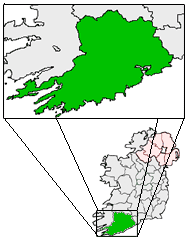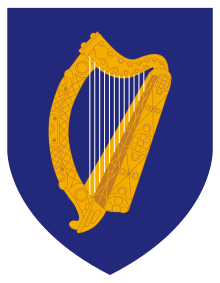Cobh
| Cobh An Cóbh |
||
 |
||
|---|---|---|
| Location | ||
|
||
| Irish grid reference W793666 |
||
| Statistics | ||
| Province: | Munster | |
| County: | Cork | |
| Elevation: | 47 m (154 ft) | |
| Population (2009) - Town: - Environs: |
10,516 17,712 |
|
| Website: www.cobh.ie | ||
Cobh (Irish: an Cóbh, meaning "cove") is a seaport town on the south coast of County Cork, Ireland with a population of around 28,639. The locality, which had had several different Irish-language names, was first referred to as Cove ("The Cove of Cork") in 1750. It was renamed Queenstown in 1849 to commemorate a visit by Queen Victoria and so remained until the name Cobh (closer to the Irish spelling) was restored in 1922 with the foundation of the Irish Free State.
Cobh is located on the south shore of the Great Island in Cork Harbour, (reputed to be the second largest natural harbour in the world), on south-facing slopes overlooking the entrance to the harbour. Facing the town of Cobh are Spike Island and Haulbowline Island. On a high point in the town stands the Cobh Cathedral, St. Colman's seat of the diocese of Cloyne.
Contents |
History of Cobh
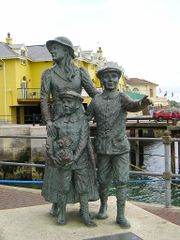
According to legend, one of the first colonists of Ireland was Neimheidh, who landed in Cork Harbour over 1000 years BC He and his followers were said to have been wiped out in a plague, but the Great Island was known in Irish as Oilean Ard Neimheadh because of its association with him. Later it became known as Crich Liathain because of the powerful Uí Liatháin kingdom who ruled in the area from Late Antiquity into the early 13th century. The island subsequently became known as Oilean Mor An Barra, (the Great Island of Barry & Barrymore) after the Barry family who inherited it.
The village on the island was known as Ballyvoloon, overlooking "The Cove" and this was first referred to as Cove village in 1750 by Smith the historian who said "it was inhabited by seamen and revenue officials". The Cork directory of 1787 shows about thirty businesses in the town including one butcher and one draper. The Water Club established at Haulbowline in 1720 was the progenitor of the present Royal Cork Yacht Club (now based in Crosshaven) and is the oldest yacht club in the world. The Royal Cork Yacht Club (RCYC) was based for many years in Cobh and the present Sirius Arts Centre was formerly a clubhouse of the RCYC organisation. In 1966 the Royal Cork Yacht Club merged with the Royal Munster Yacht Club, retaining the name of the RCYC but moving its headquarters to those of the RMYC at Crosshaven at the other side of the harbour.
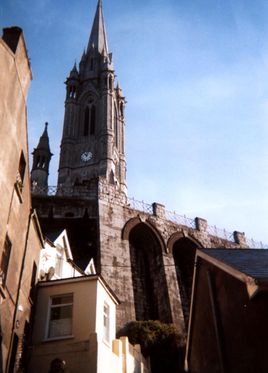
Cobh is well served by pubs and hotels and leisue facilities which include the newly built Coral Leisure Center. The oldest recorded pub on the island is reputed to have been the "Anti Gallicon" situated in the Holy Ground, and apparently liable to flooding when the tide came in. This pub dated back to the 1780s and was named after opponents to the French "Gallicon" faction who opposed the powers of the Pope.
Cove underwent rapid development in the early 1800s assisted by world events. Due to its naturally protected harbour Cobh has historically been important as a tactical base for naval military bases. For instance, Cobh was of major tactical military importance as a naval base during the Napoleonic wars between France and England. Today, the Irish Naval Service is based on Haulbowline island facing Cobh. It has eight ships based there, all armed with cannons and GPMG's. LÉ Eithne is the biggest at almost 85 metres long. She also has a helipad.
The Napoleonic Wars meant the town became a British Naval port with its own admiral and much of the present day buildings were built. The cessation of hostilities dented its prosperity for a time but it became widely known as a health resort and many convalescents came to Cove to avail of its temperate climate. Amongst these was Rev. Charles Wolfe who wrote the "Burial of Sir John Moore at Corunna" and is buried in the Old Church Cemetery outside the town.
One of the major transatlantic Irish ports, Cobh was the departure point for 2.5 million of the six million Irish people who emigrated to North America between 1848 and 1950. On 11 April 1912 Queenstown was the final port of call for the RMS Titanic as she set out across the Atlantic on her ill-fated maiden voyage. Local lore has it that a Titanic crew member John Coffey, a native of Queenstown, jumped ship although there is no record of him on the crew list. 123 passengers boarded in all; only 44 survived the sinking.
Cobh was also a major embarkation port for men, women and children who were deported to penal colonies such as Australia. The records of such deportations can be found in the ship log books in the Cobh Museum, which since 1973 is housed in Scots church (Presbyterian church until 1969 closure) overlooking the harbour.
Due to its maritime advantages, a significant shipbuilding industry developed in Cobh and the remnants of the Verolme Shipyard today maintain many of the original cranes and hoists which now form part of the significant industrial and maritime heritage of Cobh which is considered to have major tourism potential. Underutilised dockyards in Holland (e.g. NDSM/Stichting Kinetisch Noord in Amsterdam which has been redeveloped as an artistic and cultural centre and where MTV has since located) and other European countries are now emerging as major hubs of cultural and economic development, focussing on fostering creative class and knowledge-intensive industries such as media and computing. [1]. The Verolme Shipyard currently contains the Philip Gray Gallery of Fine Art [2].
The age of steam brought famous achievements to Cobh, most notably the first steam ship to sail from Ireland to England (1821) and the first steam ship to cross the Atlantic (Sirius 1838) which left from Passage West. In 1849 the name of the town was changed to Queenstown to honour Queen Victoria who visited Ireland in that year.
Several other notable ships are associated with the town, including:
- The Cunard passenger liner RMS Lusitania was sunk by a German U-Boat off the Old Head of Kinsale while en route to Liverpool in on May 7, 1915. 1198 passengers died, while 700 were rescued. The survivors and victims were brought to the town of Cobh, and over one hundred lie buried in the Old Church Cemetery just north of the town. The Lusitania Peace memorial is located in Casement Square opposite the arched building housing the Cobh Library and Courthouse.
During World War I, Queenstown was a naval base for British and American destroyers operating against U-boats that preyed upon allied merchant vessels. Q-ships (heavily armed merchant ships with concealed weaponry, designed to lure submarines into making surface attacks) were called "Q-ships" as many were fitted out in Queenstown. The first division of American destroyers arrived in May 1917, and the sailors who served on those vessels were the first American servicemen in combat duty in the war. When the convoy arrived in port, after a rough passage in what were little more than open boats, they were met with a great crowd of sailors and townspeople, thankful for their help in stopping the U-boats that were blockading western Europe. The British Commodore met the captain of the American flagship by jumping onto the dock, and asked him how soon the weather-beaten American ships could be put to use. "We're ready now, sir!" was the widely quoted answer from the Captain.
Due to its tactical military importance, under the terms of the Anglo-Irish Treaty 1921 the port remained a UK sovereign base, see Treaty Port. Along with the other Treaty ports it was handed over to the government of the Irish Free State in 1938.
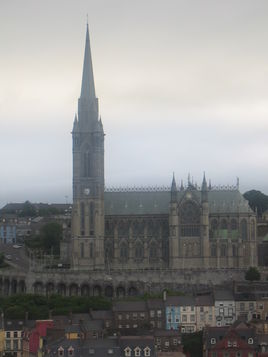
Demography and people
The population of the Cobh area has increased greatly in recent times with large new housing estates established on the outskirts of the town, placing severe pressures on the transport infrastructure. The town boundary has not yet reflected these changes in order to accommodate the new housing developments.
According to the 2006 Census, the combined population of Cobh and Great Island was 19,887 with a large amount of housing estates being built in areas such as Rushbrooke and Carrignafoy. Cobh is gradually becoming a satellite town to the nearby Cork City, and has a dynamic (and international) commuter population as can be evidenced on the hourly commuter train service to Cork city.
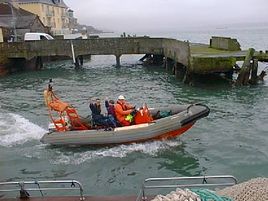
Economy
- Haulbowline Island which faces Cobh town is the headquarters of the Irish Naval Service, formerly a British naval base.
- Cobh was home to Ireland's only steelworks, the former state-owned Irish Steel works which was closed by its buyer, Ispat International, in 2001. There is a controversy over the slag heap on the steelworks, where there are concerns that it may be leaching into the harbour [3].
- Tourism is a large employer in Cobh. Large cruise liners visit Cobh each year, mainly during the summer months, although many of the tourists are transported out of Cobh by bus to other tourist destinations.
- Another important employer in Cobh had been the Dutch-owned Verolme Cork Dockyard, in Rushbrooke. It opened in 1960 and ceased operations in the mid-1980s. In 1981 the mvLeinster was built at Verolme for service on the Dublin – Holyhead route [4] The last ship built at Verolme was the Irish Naval Service's LÉ Eithne (P31) [5]. Some ship repair work is still carried at Rushbrooke using the impressive drydock[1] and other facilities. The drydock pumps are reputed to date from 1912. Due to large-scale development in Cobh many new facilities have been built and many people from Midleton, Glanmire & surrounding areas commute to Cobh each day for work and shopping purposes.
Transport and communications
- Outside of the Dublin metropolitan area, Cobh is one of the few towns in Ireland served by a commuter train service. The town is the effective southern terminus of the railway line from Dublin to Cork. Regular commuter services run between Cork city and Cobh, calling at, amongst others, Fota railway station, Carrigaloe railway station, and Rushbrooke railway station, along the way, the line ends at Cobh railway station, which opened on 10 March 1862 and was closed for goods traffic on 3 November 1975.[2]
- Nearest airport Cork Airport which can be reached in 20–30 minutes from Cobh accessible by the R624 road and the N25 road.
- The Port Operations Centre for Cork Harbour is located in the town including the Harbour pilot base at the Camber.
- A Major upgrade of the R624 road is planned with the construction of a new bridge (replaces old Belvelly bridge) and a new road from Belvelly in the North of Cobh, to Tullagreen where the R624 road joins the N25 road from Cork City to Rosslare at the N25 Carrigtwohill-Cobh Interchange.
Cobh politicians and public representatives
Cobh Town Council is the local authority governing the town of Cobh. It consists of nine elected Councillors who work with the administrative, executive and technical staff, led by the Town Manager. The Town Council has a wide range of functions in order to serve the people of Cobh. As of June 2009 the political make-up of the council is 3 Labour Party, 2 Fine Gael, 1 Fianna Fáil, 1 Sinn Féin and 2 independent councillors. The contact details of current Cobh public representatives are found on the website of the Cobh Town Council. The town is also part of the Midleton Electoral area for elections to Cork County Council and is in the Dáil constituency of Cork East.
Cobh today

Leisure and commercial activities have improved in recent years:
- In February 2008 building of the new retail park in Cobh (Ticknock) took place all units have been sold and are expected to open in January/February 2010.
- The new Aura swimming pool opened in August 2007, in January 2009 Aura Leisure group went into administration the swimming pool was closed but a break through came in June 2009 when Coral Leisure group began to operate the pool and Leisure Centre.
- There were plans to build a new marina in front of the town, but it is unclear if this will go ahead.
- Since Late 2008 when the recession began Cobh has seen a boom in new retail, restaurants and fast food openings. Many of these were in construction or planned before the economic downturn commenced.
- Cobh has many schools including Colaiste Muire secoundary school and Cobh Community College. In 2010 a planned new school development has been drawn up by the Department of Education & Science to cater for the high population and need for good education in the town.
Arts and festivals
- The main hub for the arts in Cobh is the Sirius Arts Centre located on the waterfront. It hosts many cultural events both in house and around Cobh.
- The Maritime Song Festival takes place each year in May with live performances and impromptu sing-songs of sea shanties and traditional music of the sea at the Sirius Arts Centre and a number of hostelries around Cobh and the Great Island. It also coincides with the South of Ireland Pipe Band competition.
- The Cobh Peoples Regatta is held every year around August. It is the cultural highlight of the Summer. The event traditionally includes on-stage performances from local musicians and performers as well as a Cobh pageant to decide the Queen of Cobh for the coming year. The festival ends every year with a fireworks display over the Harbour at 10pm. It attracts up to 20,000 people and is known widely around Ireland and the UK
- Cobh is the setting of the 2009 Connor McPherson film The Eclipse
People
- Anne E. Ball (1808–1872) and Mary Ball, (born Cobh, 15 Feb 1812), sisters who were pioneering scientists motivated by curiosity who contributed to the knowledge of Irish flora and fauna. They are noted as eminent scientists in the history of phycology
- Robert Ball, (born 1 April 1802, died 1857). Brother of Anne and Mary Ball. Zoologist. [6]
- Captain Thomas Brierley, awarded a medal for outstanding gallantry for his heroic part in the rescue of Lusitania victims.[7]
- Patsy Donovan, US major league baseball player
- Charles Guilfoyle Doran - Fenian and Clerk of Works throughout the building of Cobh Cathedral. Lived in the town most of his life.
- Jack Doyle, boxer, actor and crooner
- Robert Forde, (1875–1959) Antarctic explorer
- Maeve Higgins, comedian
- Stephen Ireland, Aston Villa footballer
- Sonia O'Sullivan, silver medalist in the 5000 m race at the 2000 Sydney Olympic Games
- Dr. James Roche Verling, personal physician to Napoleon Bonaparte during his exile in St. Helena
- Joseph Wheeler, 19th century founder of the Rushbrooke ship yard
- Roy Keane, former Manchester United footballer and current Ipswich manager, started his professional career with Cobh Ramblers
- Patrick Walsh (bishop) Emeritus bishop of Down and Connor was originally from here.
Sport
- Cobh's most successful football team is Cobh Ramblers, the club where Roy Keane made his name and earned a transfer to English side Nottingham Forest, as well as where current Irish international footballer and Aston Villa midfielder Stephen Ireland started his career. Cobh Ramblers most successful season came in 08/09, when they were promoted to the Eircom/Airtricity League Premier Division, which is the highest division in Ireland. They beat Athlone Town 1-0 on the last day of the season to secure promotion. Aprrox 3,500 Ramblers fans made the trip to Athlone Stadium for the game. After a close first season they were relegated to the A championship. As of 2010 Cobh Ramblers are in the hands of the FAI which wil provide finance to see the club back to the top of Irish Football.
- Cobh Golf Club has a new 18-hole championship course at Marino on the main road R624 into Cobh.
- Rushbrooke rowing club is also a very successful club in Cobh.
- Cobh GAA is the center for gaelic games on the island, such as hurling and gaelic football, and is located at Carrignafoy
- The inaugural Cobh 10 mile road race will take place on 18 April 2010 on the streets of Cobh and the roads of the Great Island. Called the Great Island 10, all proceeds will go to the Irish Cancer Society.
Twin towns
 - Kolbuszowa, Subcarpathian Voivodeship, Poland
- Kolbuszowa, Subcarpathian Voivodeship, Poland
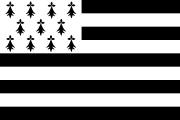 - Ploërmel, Brittany, France
- Ploërmel, Brittany, France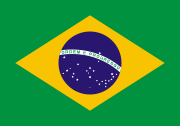 - Cruzeiro, São Paulo, Brazil
- Cruzeiro, São Paulo, Brazil - Lake Charles, Louisiana, USA
- Lake Charles, Louisiana, USA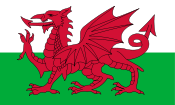 - Pontarddulais, Wales[3]
- Pontarddulais, Wales[3]
See also
- List of towns and villages in Ireland
- Cork Suburban Rail
- Metropolitan Cork
- The Emergency
- Plan W
External links
- Cobh Community Care - Day Care Centre and Housing for the elderly
- Cobhnet.com - business & community directory with online Forum
- CobhOnline, Cobh's Home on The Net
- Cobh Golf Club
- Census 2006 Preliminary Report
- Cobh railway station
- Cobh & Harbour Chamber of Commerce
- Cobh Heritage Centre
- Cobh Sirius Arts Centre
- Cobh Museum
- Cobh GAA
- Cobh Tourism
- Christmas in Cobh
- Cobh Town Council
- Great Island 10 mile Road Race
tourism
References
- ↑ See Joseph Wheeler (shipbuilder)
- ↑ "Cobh station" (PDF). Railscot - Irish Railways. http://www.railscot.co.uk/Ireland/Irish_railways.pdf. Retrieved 2007-08-31.
- ↑ http://www.pontarddulaistowncouncil.gov.uk/Core/Pontarddulais-Tc/Pages/Twinning_1.aspx
|
|||||||||||||||||||||||||||||||||
